Ketan Serundeng
Ketan Serundeng is sticky rice at its finest—steamed until tender and topped with a flavorful mix of sweet, spicy, and savory coconut shreds. It’s a time-honored snack from the Betawi community in West Java that’s still popular today for its taste.
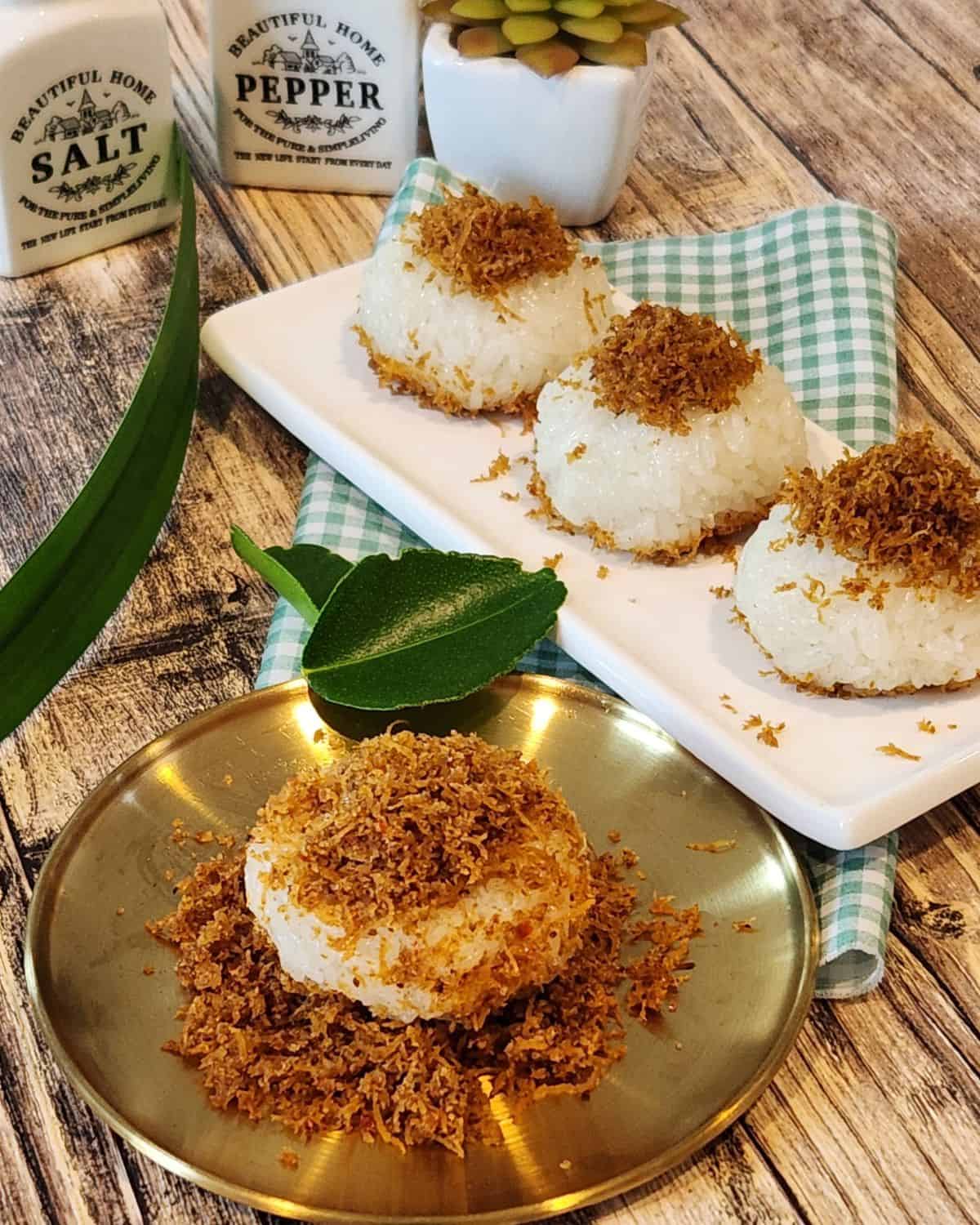
If you love sticky rice desserts like mango sticky rice, palm sugar wajik, or pulut hitam, then you need to try Ketan Serundeng. This one comes from the Betawi tradition and pairs soft, chewy glutinous rice with a sweet, savory, and slightly spicy coconut topping called serundeng. It’s bold, aromatic, and super satisfying. You can even pair it with rice and fried chicken.
I grew up eating all kinds of sticky rice snacks—lemper, wajik pandan, even kuih seri muka—and I love how each one has its own personality. Seri Muka has that soft pandan custard layer, while Ketan Serundeng hits you with crunch, spice, and coconut umami. Simple, but so addictive.
If you’re a fan of sticky rice in all its forms, this one deserves a spot on your must-make list!
Why You Will Love This Recipe
Recipe Ingredients
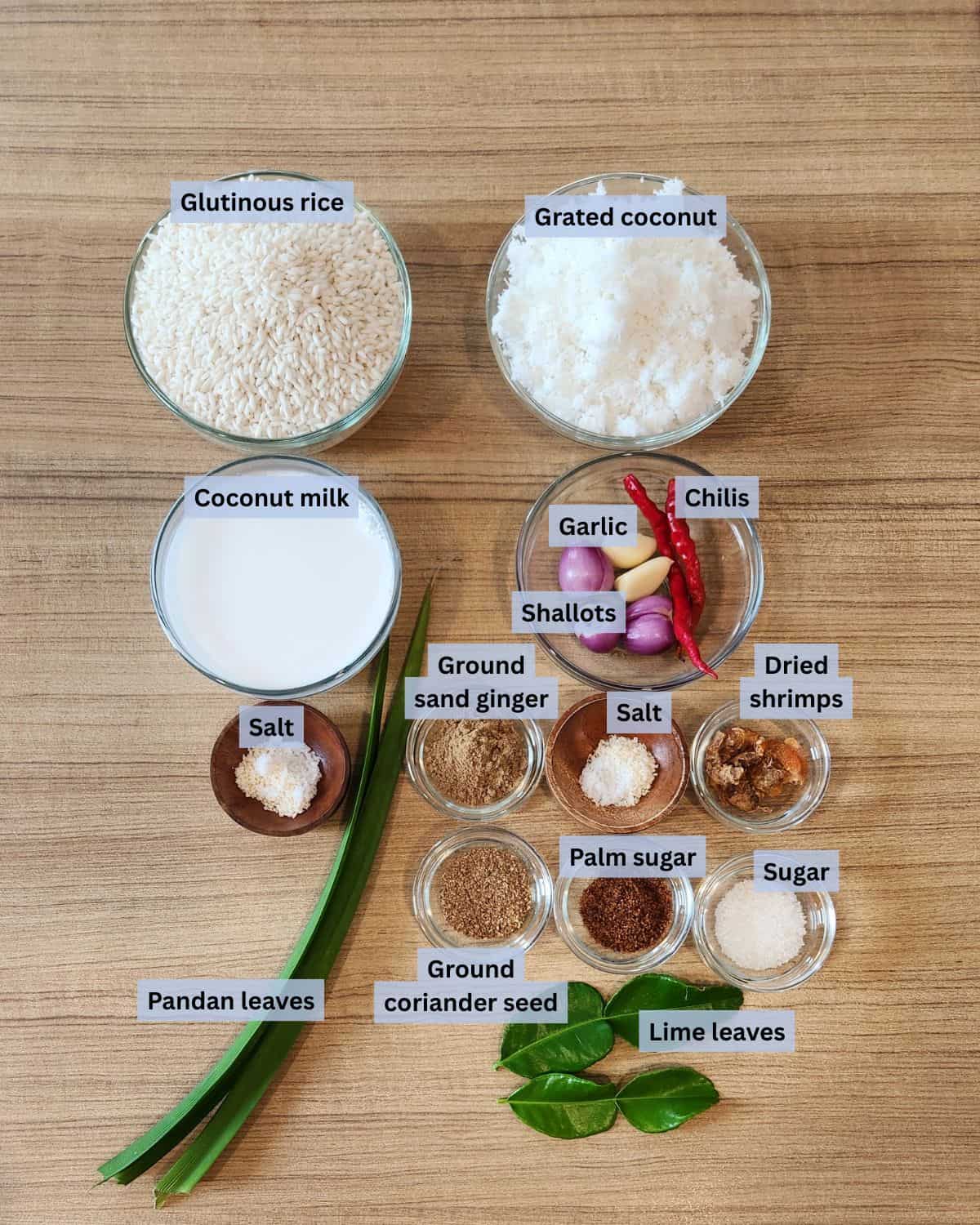
Ingredient Notes
Sticky Rice – Use white glutinous rice or sticky rice. Please keep in mind that sticky rice is much whiter than regular rice.
Grated Coconut – Try using freshly grated coconut as much as possible. If you really can’t find it in your area, use dessicated or dried coconut and add some coconut milk or water. Dried coconut must be rehydrated to add moistness back to it.
Spices And Herbs – Spices would include red shallot, garlic, red chili, ground coriander seed, lime leaves. Nowadays, it is easy to find the dried version or ground form of the spices.
Be sure to check out the full recipe and ingredient list below
How To Make Ketan Serundeng
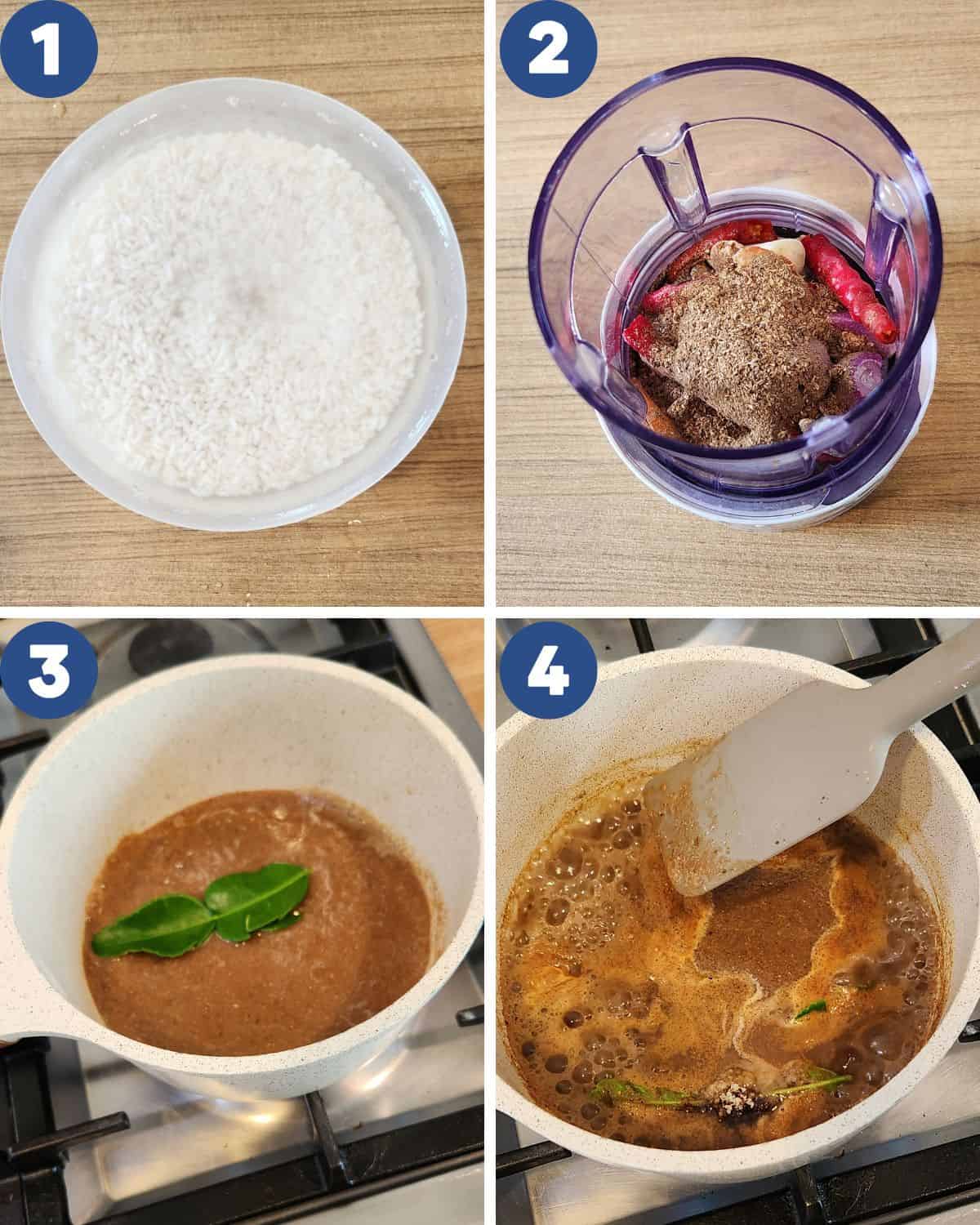
STEP 1. Rinse the glutinous rice 2–3 times until the water runs clear. Soak it in clean water for at least 1 hour (Image 1). Meanwhile, prepare the spice paste for the coconut topping. In a food processor, blend garlic, shallots, chilies, ground coriander, dried shrimp, and ground sand ginger into a smooth paste (Image 2).
Transfer the spice paste to a saucepan (Image 3). Add lime leaves, salt, and sugar (Image 4). Cook over medium heat, stirring occasionally, until the mixture is fragrant and most of the liquid has evaporated.
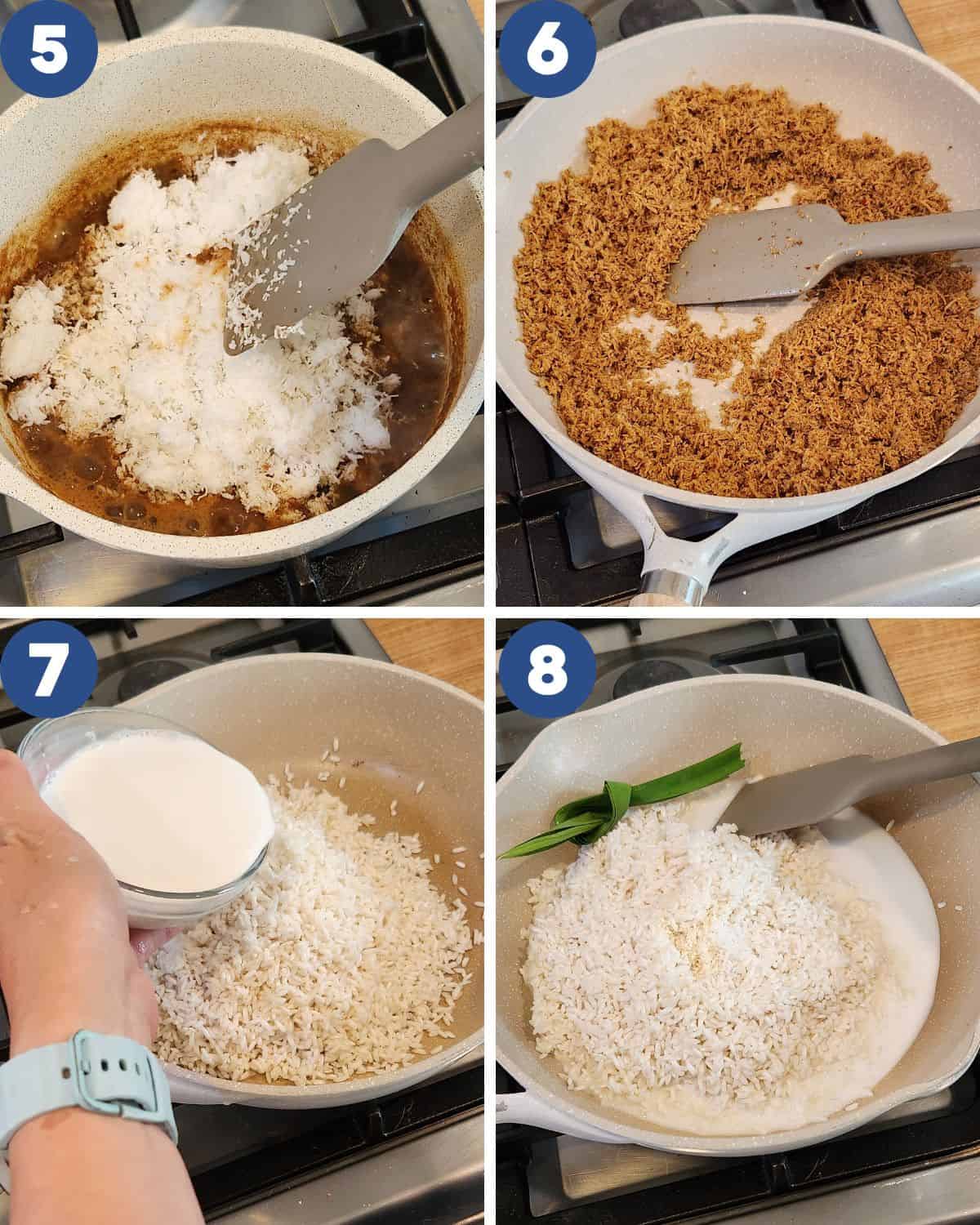
STEP 2. Add the grated coconut to the pan (Image 5). Stir well until the spice mixture is evenly incorporated. Continue cooking over medium-low heat, stirring often, until the coconut is dry and fragrant (Image 6). Set the serundeng or spiced coconut aside to cool.
Once the rice has finished soaking, drain the water and transfer the rice to a pot. Add coconut milk, pandan leaves, and a pinch of salt (Images 7, 8).
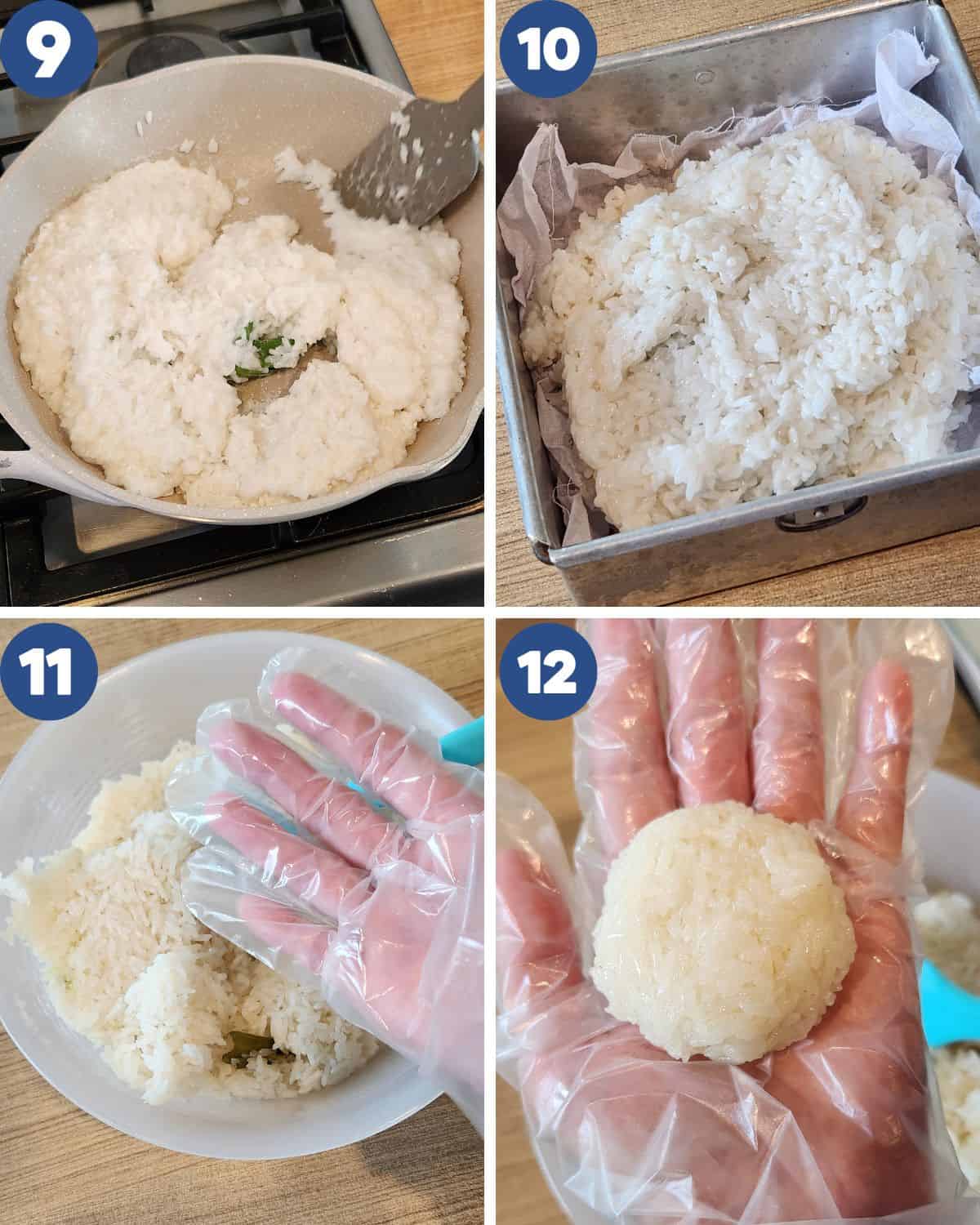
STEP 3. Cook the rice over medium heat, stirring gently, until all the coconut milk is absorbed (Image 9). Transfer the partially cooked rice to a steamer and steam for about 45 minutes, or until fully cooked and tender (Image 10).
Once done, remove from the steamer. While the rice is still warm, shape it as desired—use lightly oiled hands to prevent sticking (Images 11, 12).
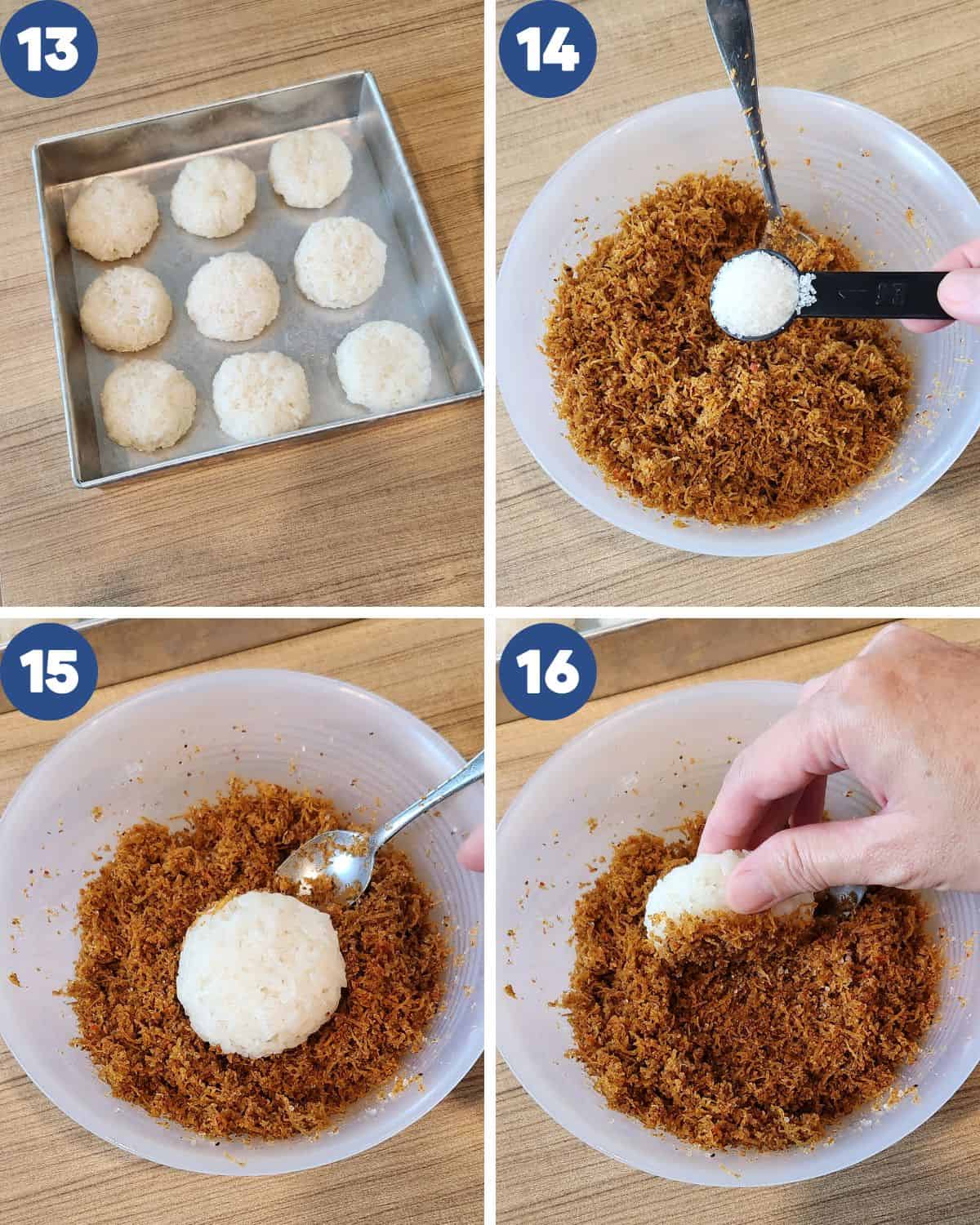
STEP 4. Once all the sticky rice is shaped (Image 13), sprinkle 1–4 teaspoons of sugar into the cooled serundeng and mix well to create a slightly crunchy texture (Image 14).
Coat each piece of sticky rice with the serundeng, pressing gently so it sticks well (Images 15, 16). Repeat until all pieces are covered. Enjoy your Ketan Serundeng!
Pro Tips
- Tear the lime leaves. Before adding lime leaves to the pan, tear or bruise them slightly to release more of their citrusy aroma. It’ll make your serundeng extra fragrant and inviting.
- Toast the coconut slightly for a nuttier, deeper flavor. Just be sure to stir constantly so it doesn’t burn—serundeng can go from golden to “oops” very quickly.
- Taste the serundeng before finishing—adjust the sugar, salt, or chili level depending on whether you want it sweeter, spicier, or more savory.
- Make ahead and reheat: The serundeng can be made ahead and stored in an airtight container for up to a week. Re-toast in a dry pan for a few seconds before serving to revive the aroma.
How to Serve
Ketan Serundeng is best served at room temperature, perfect for an afternoon snack or tea-time treat. Pair it with a warm cup of wedang jahe, lemon ginger tea, or a glass of butterfly pea flower tea.
Serve it alongside other Indonesian favorites like pandan serabi, kue cucur, and ongol-ongol. Each one brings a unique flavor and texture—making your spread complete.
FAQs about Ketan Serundeng
Ketan Serundeng is made with steamed glutinous rice (ketan) and topped with serundeng—a dry coconut topping flavored with spices, chilies, herbs, and sometimes dried shrimp. The topping is sweet, savory, and aromatic.
It’s both! The serundeng topping is a beautiful balance of sweet, salty, and spicy, which pairs perfectly with the plain sticky rice base.
The glutinous rice is soaked, then cooked with coconut milk, salt, and pandan leaves until the liquid is absorbed. It’s then steamed until fully tender and sticky.
Yes! You can prepare the serundeng a few days in advance and store it in an airtight container. Steam the sticky rice fresh when you’re ready to serve.
Yes! Ketan Serundeng is naturally gluten-free as long as none of the seasonings or flavorings contain added wheat. Always check your ingredients if you’re cooking for someone with celiac disease.
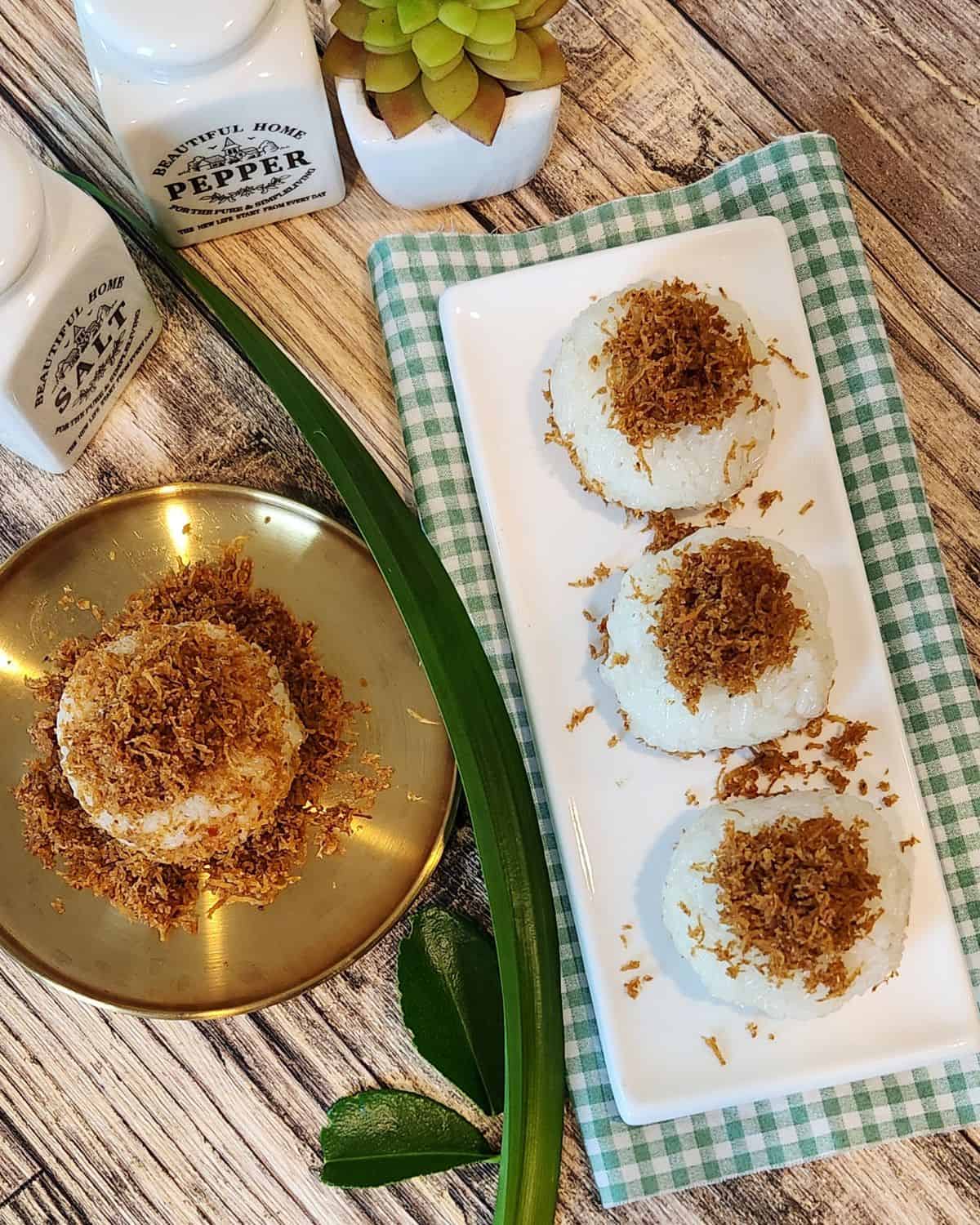
Storage
Store any leftover Ketan Serundeng in an airtight container at room temperature for up to 1 day, or in the fridge for up to 3 days. If storing in the fridge, let it come to room temperature or gently steam it to soften the rice again before serving.
You can also store the serundeng (coconut topping) separately in a dry, airtight jar for up to 1 week. Give it a quick toast in a dry pan to refresh the flavor and crunch before serving.
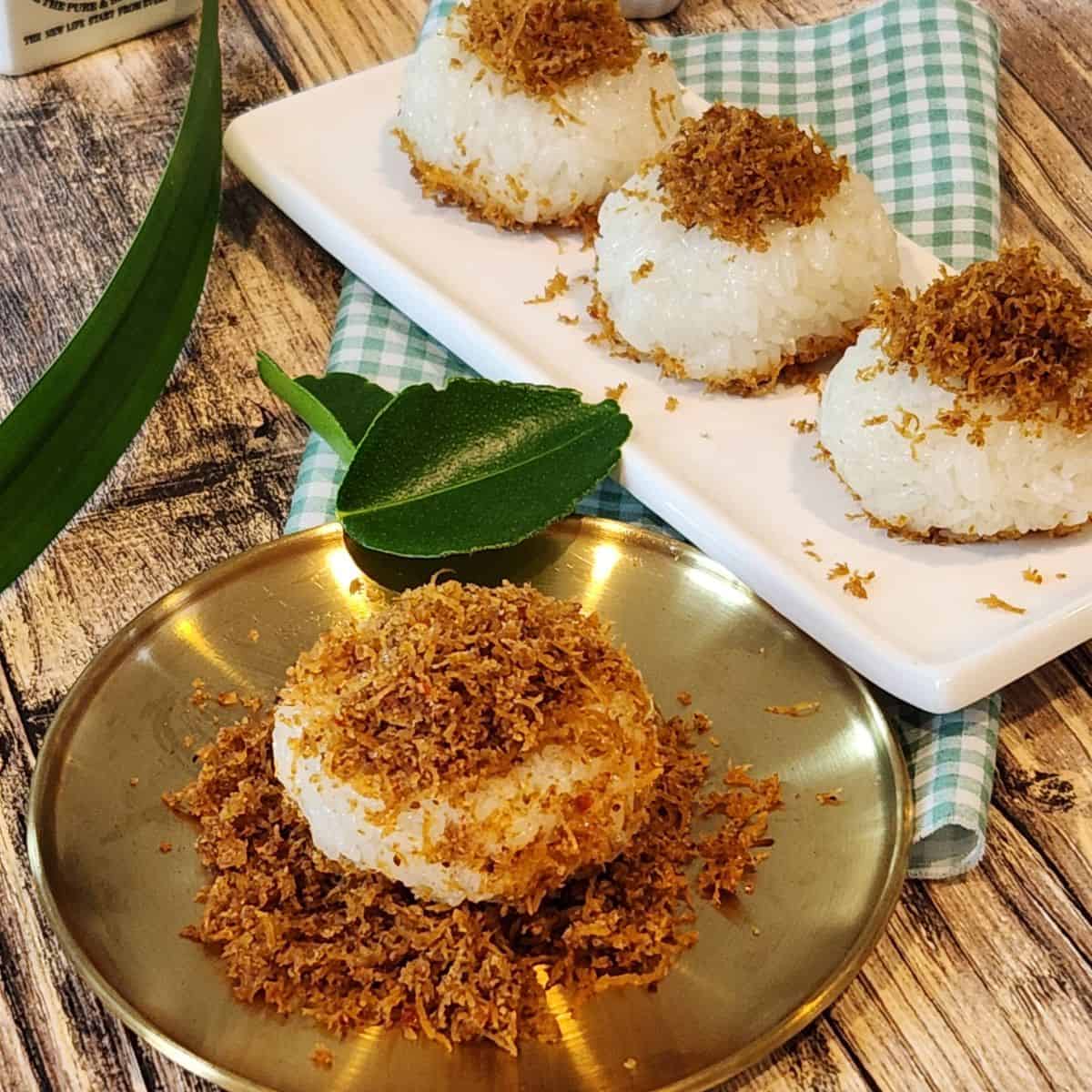
Ketan Serundeng
Ingredients
Sticky rice
- 400 gr glutinous rice
- 150 cc coconut milk
- 1-2 pcs pandan leaves
- 1 tsp salt
Serundeng
- 150 gr freshly grated coconut
- 3 pcs red shallot
- 2 pcs garlic
- 2 pcs red chilli
- ½ tbsp coriander seed powder
- ½ tbsp sugar
- ½ tbsp brown sugar
- 1 tsp salt
- 2-3 pcs lime leaves
- 5 gr dried shrimp optional
- 5 gr sand ginger powder
Instructions
- Rinse the glutinous rice 2–3 times until the water runs clear. Soak it in clean water for at least 1 hour. Meanwhile, prepare the spice paste for the coconut topping. In a food processor, blend garlic, shallots, chilies, ground coriander, dried shrimp, and ground sand ginger into a smooth paste.Transfer the spice paste to a saucepan. Add lime leaves, salt, and sugar. Cook over medium heat, stirring occasionally, until the mixture is fragrant and most of the liquid has evaporated.
- Add the grated coconut to the pan. Stir well until the spice mixture is evenly incorporated. Continue cooking over medium-low heat, stirring often, until the coconut is dry and fragrant. Set the serundeng or spiced coconut aside to cool.Once the rice has finished soaking, drain the water and transfer the rice to a pot. Add coconut milk, pandan leaves, and a pinch of salt.
- Cook the rice over medium heat, stirring gently, until all the coconut milk is absorbed. Transfer the partially cooked rice to a steamer and steam for about 45 minutes, or until fully cooked and tender.Once done, remove from the steamer. While the rice is still warm, shape it as desired—use lightly oiled hands to prevent sticking.
- Once all the sticky rice is shaped, sprinkle 1–4 teaspoons of sugar into the cooled serundeng and mix well to create a slightly crunchy texture.Coat each piece of sticky rice with the serundeng, pressing gently so it sticks well. Repeat until all pieces are covered. Enjoy your Ketan Serundeng!
Video
Notes
- Tear the lime leaves. Before adding lime leaves to the pan, tear or bruise them slightly to release more of their citrusy aroma. It’ll make your serundeng extra fragrant and inviting.
- Toast the coconut slightly for a nuttier, deeper flavor. Just be sure to stir constantly so it doesn’t burn—serundeng can go from golden to “oops” very quickly.
- Taste the serundeng before finishing—adjust the sugar, salt, or chili level depending on whether you want it sweeter, spicier, or more savory.
- Make ahead and reheat: The serundeng can be made ahead and stored in an airtight container for up to a week. Re-toast in a dry pan for a few seconds before serving to revive the aroma.






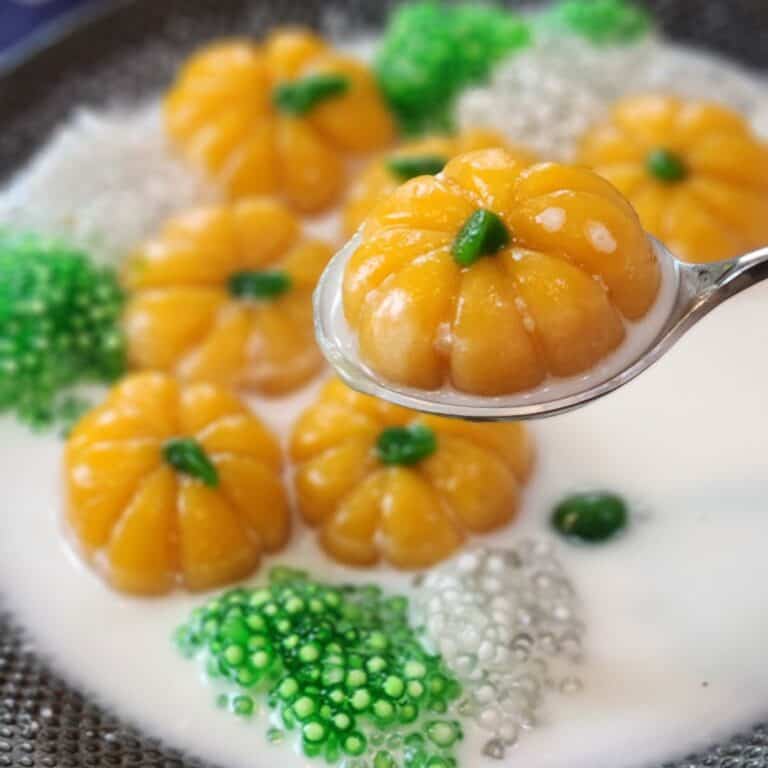
I love the flavor combination from the chewy sticky rice and coconut topping, it is sweet, savory, and spicy into one bite!